Hi there! I’m Emma Lee, a foreign food blogger who has been living in China for several years. I have a deep passion for discovering everything from humble street breakfasts to elegant Michelin-starred Chinese restaurants. Whether it’s a steaming stall tucked in a Beijing alley or a high-end dining spot hidden in Shanghai, every bite has deepened my appreciation for Chinese culinary culture. This article is for anyone curious about Chinese breakfast. Whether it’s your first trip to China or you’re planning a more immersive experience, I hope this guide inspires your very first bite of the morning.
Summary
What Do Chinese People Eat for Breakfast?
You’ve probably heard that Chinese breakfast comes in many forms—and it’s true. Each city has its own unique breakfast traditions, and the contrast between northern and southern China is especially striking. For example, breakfast in Beijing is vastly different from that in Guangzhou. Here are a few of the most common and beloved breakfast foods across China. If you’re curious about local specialties, scroll down to explore regional breakfast traditions.
Doujiang Youtiao
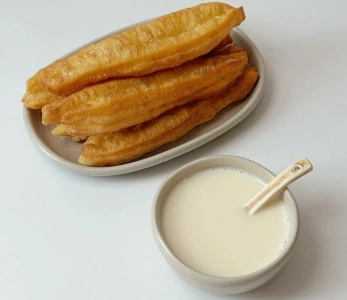
Doujiang youtiao—soy milk and fried dough sticks—is one of the most iconic Chinese breakfast foods and can be found almost everywhere in China. A cup of hot, freshly ground soy milk paired with crispy golden youtiao makes for a hearty, affordable meal. It’s often considered the nation’s go-to breakfast.
- Chinese Name: 豆浆油条
- Pinyin: dòu jiāng yóu tiáo
- Main Ingredients: soybeans, flour, edible alkali, salt
Mantou / Baozi

Mantou (steamed buns without filling) and baozi (stuffed buns) are staples in northern China. Easy to grab and filling, they’re available at nearly every street vendor or breakfast shop. Fillings for baozi vary from pork and cabbage to egg and sweet bean paste. Mantou, on the other hand, is plain dough—simple but satisfying.
- Chinese Name: 馒头 / 包子
- Pinyin: mán tóu / bāo zi
- Main Ingredients: flour, yeast, water (baozi fillings may include pork or vegetables)
Xifan (Rice Porridge)

Xifan is a rice porridge made by boiling rice until soft and slightly soupy. It has a mild taste and is often served with pickled vegetables, peanuts, or century eggs. This dish is a comforting, easy-to-digest breakfast that’s especially popular in households with kids or elderly family members.
- Chinese Name: 稀饭
- Pinyin: xī fàn
- Main Ingredients: rice, water (optional add-ins: pickles, century egg, peanuts)
Jidanbing / Jianbing Guozi

Jidanbing and jianbing guozi are two of the most popular street breakfast foods in China. Jidanbing is a thin pancake made from batter and egg, while jianbing guozi—originally from Tianjin—is more elaborate. It’s made with mung bean flour and filled with youtiao, crunchy wafers, scallions, and savory sauces. Office workers especially love it for its rich flavors and portability.
- Chinese Name: 鸡蛋饼 / 煎饼果子
- Pinyin: jī dàn bǐng / jiān bǐng guǒ zi
- Main Ingredients: batter, eggs, scallions, crispy cracker, sweet sauce
Mifen / Mixian (Rice Noodles)
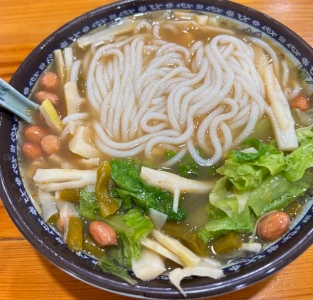
Popular in southern Chinese cities like Guangxi and Yunnan, mifen and mixian are rice noodles served hot in flavorful broth. They’re often topped with beef slices, pickled vegetables, cilantro, and chili oil. With steam rising from the bowl, this breakfast is a perfect way to start a chilly morning.
- Chinese Name: 米粉 / 米线
- Pinyin: mǐ fěn / mǐ xiàn
- Main Ingredients: rice, water, meat broth, pickled vegetables, chili
Tea Egg

Tea eggs are hard-boiled eggs simmered in a fragrant broth made from soy sauce, tea leaves, and star anise. Cracks in the shell give the egg a beautiful marbled look. You’ll find them at convenience stores and breakfast stalls throughout China. They’re savory, portable, and very affordable.
- Chinese Name: 茶叶蛋
- Pinyin: chá yè dàn
- Main Ingredients: eggs, soy sauce, tea leaves, star anise
Regional Chinese Breakfasts – What Locals Eat Across China
Beijing
Beijing is not only China’s political capital but also a culinary city deeply rooted in tradition. Locals enjoy breakfast that reflects the flavors of old Beijing—from the hearty savoriness of zhajiang mian to the fermented tang of douzhi. These dishes show a northern Chinese preference for warmth and substance in the morning.
Want to explore more about traditional Beijing flavors? Click here to view our Beijing Food Guide.
Beijing Zhajiang Mian
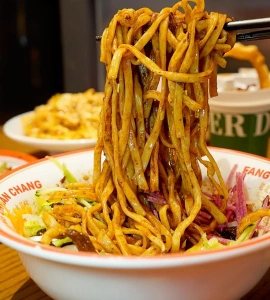
Zhajiang mian is a noodle dish that captures Beijing’s regional character. Handmade noodles are topped with stir-fried minced pork in fermented soybean paste and garnished with crunchy vegetables like cucumber, mung bean sprouts, and radish. It’s rich, salty, and one of the city’s top choices for breakfast or lunch.
- Chinese Name: 北京炸酱面
- Pinyin: běi jīng zhà jiàng miàn
- Main Ingredients: handmade noodles, fermented soybean paste, minced pork, shredded cucumber
Douzhi (Fermented Mung Bean Drink)

Douzhi is a traditional fermented drink unique to Beijing, made from mung bean residue. It has a distinct sour flavor that can be surprising to first-time visitors, but many Beijingers grew up drinking it. It’s typically served with jiaoquan (crispy rings) and pickled vegetables for contrast.
- Chinese Name: 豆汁
- Pinyin: dòu zhī
- Main Ingredients: mung beans, fermented mung bean mash, pickles
Doufunaor (Savory Tofu Pudding)
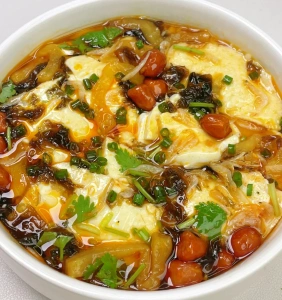
This silky and delicate tofu pudding is a classic northern Chinese breakfast, especially in Beijing. Unlike the sweet versions found elsewhere, Beijing’s version is savory—flavored with soy sauce, garlic juice, minced pork, and dried shrimp. It’s easy to digest and popular with both children and seniors.
- Chinese Name: 豆腐脑
- Pinyin: dòu fu nǎo
- Main Ingredients: soybeans, water, soy sauce, dried shrimp, minced pork
Jianbing Guozi

Originally from Tianjin, jianbing guozi has become a breakfast staple on Beijing streets. It’s made with mung bean or wheat batter, then filled with youtiao (fried dough), egg, crispy crackers, scallions, and sweet bean paste. Its portability and bold flavors make it a favorite for office workers on the go.
- Chinese Name: 煎饼果子
- Pinyin: jiān bǐng guǒ zi
- Main Ingredients: batter, egg, fried dough stick, crispy cracker, scallions, sweet bean sauce
Shanghai
Breakfast in Shanghai reflects the refined and layered nature of Jiangnan cuisine. Unlike the hearty, bread-heavy meals of northern China, Shanghai mornings are marked by texture and taste—from crispy flatbreads to sticky rice rolls and warm soy milk, every bite carries the city’s graceful charm.
Want to explore more about Shanghai’s local cuisine and breakfast culture? Click here to view our Shanghai Food Guide.
Dabing (Sesame Flatbread)
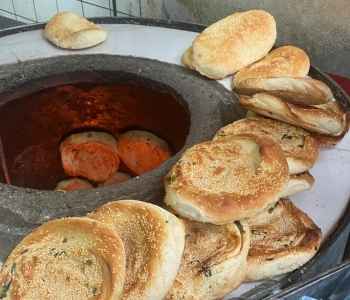
Dabing is a baked flatbread made with fermented dough and topped with sesame seeds. It’s crispy on the outside and tender inside. Traditionally eaten on its own or stuffed with youtiao, egg, or pickles, it’s part of the classic “triple-carb breakfast” loved by locals.
- Chinese Name: 大饼
- Pinyin: dà bǐng
- Main Ingredients: flour, sesame seeds, oil, fermented dough
Youtiao (Fried Dough Stick)

Youtiao is one of the most common fried breakfast items in Shanghai. Golden and crispy, it’s often wrapped inside sticky rice rolls or dipped into hot soy milk. For many Shanghainese, it’s a nostalgic symbol of childhood mornings.
- Chinese Name: 油条
- Pinyin: yóu tiáo
- Main Ingredients: flour, water, baking soda, cooking oil
Cifan Tuan (Sticky Rice Roll)

A heavier breakfast option in Shanghai, cifan tuan is made by wrapping youtiao, pork floss, and pickled vegetables inside sticky glutinous rice. The result is a dense, savory-sweet roll that’s chewy and satisfying—perfect for commuters rushing to catch the metro.
- Chinese Name: 糍饭团
- Pinyin: cí fàn tuán
- Main Ingredients: sticky rice, fried dough stick, pork floss, pickled vegetables
Soy Milk
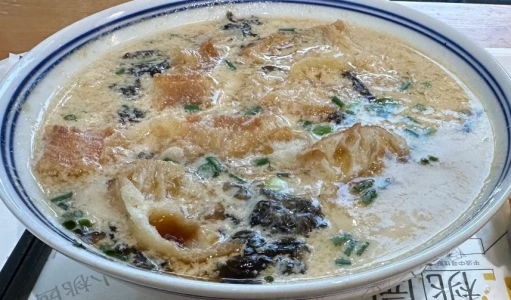
Soy milk is a daily staple in Shanghai’s breakfast culture. It’s traditionally homemade, rich, and smooth. Locals drink it sweet or savory—sometimes even adding vinegar and pickled mustard greens to make xian doujiang (savory soy milk). It’s most commonly paired with youtiao or dabing.
- Chinese Name: 豆浆
- Pinyin: dòu jiāng
- Main Ingredients: soybeans, water
Guangzhou / Zhuhai
Guangzhou and Zhuhai both belong to Guangdong Province and share a strong culinary foundation in Cantonese cuisine. In particular, Guangzhou is world-famous for its dim sum breakfast culture. Every morning, diners gather at traditional tea houses, enjoying tea and dim sum together in a relaxed and sociable atmosphere.
Want to explore more about Guangzhou’s dim sum culture? Click here to view our Guangzhou Food Guide.
Curious about how dim sum is served in Zhuhai? Click here to view our Zhuhai Food Guide.
Char Siu Bao (BBQ Pork Buns)
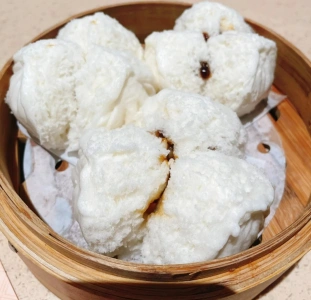
Char siu bao is one of the most popular items in a Cantonese dim sum breakfast. The fluffy white bun is filled with sweet-savory barbecued pork. One bite releases a burst of meaty flavor and sauce—it’s a comforting taste many locals have grown up with.
- Chinese Name: 叉烧包
- Pinyin: chā shāo bāo
- Main Ingredients: fermented dough, barbecued pork, soy sauce, sugar
Har Gow (Shrimp Dumplings)
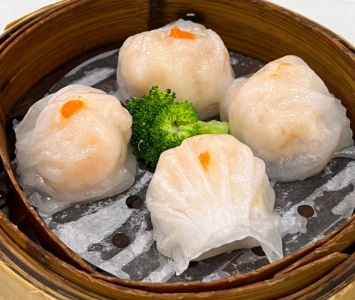
Har gow is a signature dim sum item known for its translucent skin and plump shrimp filling. The wrapper is thin yet firm, and the shrimp remains juicy and springy. Paired with a cup of hot tea, it’s a must-have at any authentic Cantonese breakfast.
- Chinese Name: 虾饺
- Pinyin: xiā jiǎo
- Main Ingredients: fresh shrimp, wheat starch (cheng fen), pork lard
Siu Mai (Steamed Pork Dumplings)

Siu mai is another classic dish found on every dim sum cart. These open-faced dumplings are filled with minced pork, and often include shrimp or mushrooms. Their flower-like tops and rich flavor make them a staple of any Guangdong-style breakfast.
- Chinese Name: 干蒸烧卖
- Pinyin: gān zhēng shāo mài
- Main Ingredients: pork, shiitake mushrooms, wheat starch, shrimp
Red Rice Noodle Rolls
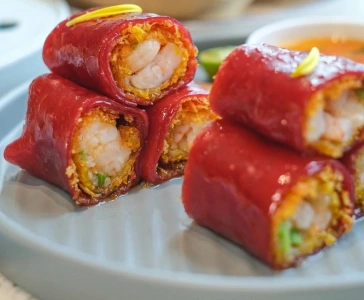
A colorful twist on a traditional rice noodle dish, red rice noodle rolls are made using red rice batter, giving them a vibrant hue. They are typically filled with beef, char siu, or vegetables and served with soy sauce, sesame paste, or peanut sauce. The texture is soft and silky with rich layers of flavor.
- Chinese Name: 红米肠
- Pinyin: hóng mǐ cháng
- Main Ingredients: red rice batter, beef or char siu, soy sauce, sesame paste
Shenzhen
As a modern city built by migrants from across China, Shenzhen’s breakfast scene reflects a blend of regional tastes. You’ll find beloved southern dishes like rice rolls and congee alongside northern staples like soy milk and fried dough. This variety makes Shenzhen a perfect place to sample the diversity of Chinese breakfast culture in one city.
Want to see how Shenzhen fuses northern and southern flavors? Click here to view our Shenzhen Food Guide.
Changfen (Rice Noodle Rolls)

Changfen is a popular street breakfast in Guangdong and Shenzhen. A thin sheet of rice batter is steamed and rolled with fillings like beef, egg, or vegetables. It’s made to order and served warm, often topped with sweet soy sauce and peanut sauce for extra flavor.
- Chinese Name: 肠粉
- Pinyin: cháng fěn
- Main Ingredients: rice batter, beef or egg, oil, soy sauce, peanut sauce
Jidi Zhou (Scholars’ Congee)
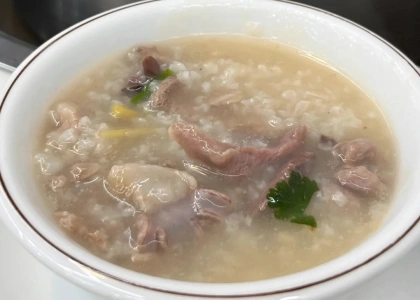
Jidi zhou is a well-known congee variety in Guangdong, said to be named after ancient scholars who passed the imperial exam. The smooth rice porridge is paired with flavorful toppings like pork liver, lean meat, and pork intestines. It’s considered a “power breakfast” that’s both hearty and nourishing.
- Chinese Name: 及第粥
- Pinyin: jí dì zhōu
- Main Ingredients: rice, pork liver, pork meat, pork intestines, ginger
Doujiang Youtiao (Soy Milk & Fried Dough)

Although this combo originated in northern China, doujiang youtiao is very common in Shenzhen. A warm cup of soy milk paired with crispy fried dough is a quick and comforting breakfast for busy commuters and students. It’s a great example of how regional cuisines come together in this city.
- Chinese Name: 豆浆油条
- Pinyin: dòu jiāng yóu tiáo
- Main Ingredients: soybeans, flour, edible alkali, salt
Chengdu
As the culinary heart of southwest China, Chengdu offers much more than hot pot and skewers—its Chinese breakfast culture is just as impressive. Locals love to start their day at bustling street stalls, enjoying a spicy bowl of feichang fen or a fragrant serving of dandan noodles. In Chengdu, breakfast is meant to be bold and flavorful.
Want to discover more about spicy breakfasts and snacks in Chengdu? Click here to view our Chengdu Food Guide.
Long Chaoshou (Sichuan-Style Wontons)
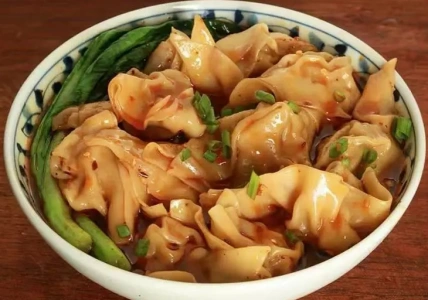
Long chaoshou is one of the most iconic Chengdu breakfast dishes—essentially Sichuan-style wontons. The wrappers are thin and silky, the fillings tender, and the broth lightly spicy with red chili oil, scallions, and vinegar. It’s one of the city’s go-to warm noodle soups in the morning.
- Chinese Name: 龙抄手
- Pinyin: lóng chāo shǒu
- Main Ingredients: pork, wonton wrappers, scallions, chili oil, chicken broth
Feichang Fen (Intestine Noodles)

This deeply flavored street breakfast is beloved by locals. The chewy sweet potato noodles are served in a spicy broth with tender braised pork intestines. Topped with chili oil, Sichuan peppercorn, and scallions, each bite bursts with bold and layered flavor—perfect for heat lovers.
- Chinese Name: 肥肠粉
- Pinyin: féi cháng fěn
- Main Ingredients: sweet potato noodles, pork intestines, chili oil, Sichuan peppercorn, broth
Guokui (Stuffed Flatbread)
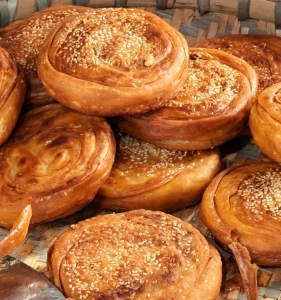
Guokui is a crispy yet chewy baked flatbread, shaped like a shield. In Chengdu, it comes in both sweet and savory varieties. The savory versions are usually filled with minced pork, fermented bean paste, or preserved vegetables. A simple and portable choice, it’s a common breakfast on the go.
- Chinese Name: 锅盔
- Pinyin: guō kuī
- Main Ingredients: flour, minced pork, doubanjiang (fermented bean paste), sesame
Dandan Noodles
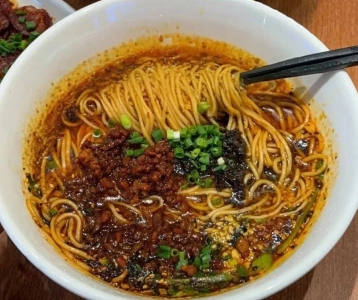
A spicy legend from Sichuan cuisine, dandan noodles got their name from the shoulder poles used to carry them by street vendors. Thin, springy noodles are topped with a savory minced pork chili sauce, along with crushed peanuts, scallions, and preserved vegetables. It’s a spicy-sweet bowl that many locals can’t start their day without.
- Chinese Name: 担担面
- Pinyin: dàn dàn miàn
- Main Ingredients: wheat noodles, minced pork, soy sauce, preserved vegetables, chili oil
Hangzhou
As one of the cultural gems of Jiangnan, Hangzhou’s breakfast culture is soft, mild, and aromatic. Whether it’s a juicy pork bun, a hot bowl of soy milk, or a sip of Dragon Well green tea, mornings here begin with elegance and comfort.
Want to dive deeper into Hangzhou’s regional flavors? Click here to view our Hangzhou Food Guide.
Shengjian Bao (Pan-Fried Soup Dumplings)

Shengjian bao are crispy-bottomed buns filled with juicy pork or a mix of seafood and vegetables. The top is soft and fluffy, while the bottom is golden and crunchy. Known for their “soup burst,” they should be eaten carefully—one small bite at a time.
- Chinese Name: 生煎包
- Pinyin: shēng jiān bāo
- Main Ingredients: flour, pork, scallion, soy sauce, sesame
Doujiang Youtiao (Soy Milk & Fried Dough)

In Hangzhou, this classic Chinese breakfast combo is given a local twist. Salty soy milk is often garnished with scallions and pickled mustard stems. Paired with crispy youtiao, it’s simple yet endlessly comforting—and commonly enjoyed with shengjian or soup dumplings.
- Chinese Name: 豆浆油条
- Pinyin: dòu jiāng yóu tiáo
- Main Ingredients: soybeans, flour, edible alkali, salt
Beef Vermicelli Soup
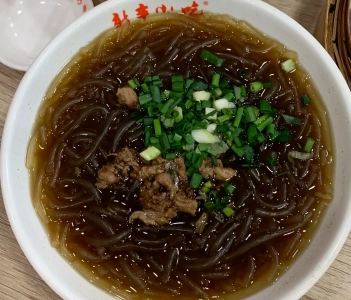
This affordable and warming breakfast is a street-food favorite. Thin glass noodles are served in a light broth, topped with tender braised beef, cilantro, and chili oil. Nourishing and flavorful, it’s especially popular on cold Hangzhou mornings.
- Chinese Name: 牛肉粉丝
- Pinyin: niú ròu fěn sī
- Main Ingredients: glass noodles, braised beef, broth, cilantro, chili oil
Chongqing
Chongqing’s breakfast is just like the city itself—fiery, bold, and unapologetic. Whether it’s a steaming bowl of xiaomian or the addictive sourness of suanlafen, breakfast here hits hard and wakes you up fast.
Curious about the spicy breakfasts of Chongqing? Click here to view our Chongqing Food Guide.
Chongqing Xiaomian (Spicy Noodles)
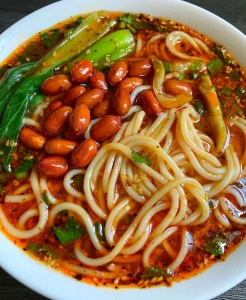
Xiaomian is the city’s beloved “soul breakfast.” Though the toppings are simple, the seasoning is complex—must be spicy, numbing, savory, and aromatic. With chewy alkaline noodles swimming in chili-laced broth, one bowl sets the tone for the day.
- Chinese Name: 重庆小面
- Pinyin: chóng qìng xiǎo miàn
- Main Ingredients: alkaline noodles, chili oil, Sichuan pepper, garlic paste, soy sauce
Suanlafen (Hot and Sour Noodles)
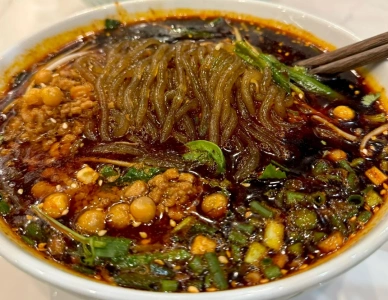
A street snack turned breakfast staple, suanlafen is made with slippery sweet potato noodles in a tangy-spicy soup. Toppings include scallions, crispy peanuts, and preserved mustard. It’s sour, spicy, chewy—and addictively delicious.
- Chinese Name: 酸辣粉
- Pinyin: suān là fěn
- Main Ingredients: sweet potato noodles, chili oil, vinegar, peanuts, preserved vegetables
Youcha (Chongqing Spiced Tea Soup)

Youcha is a traditional breakfast drink still found in some old neighborhoods of Chongqing. Made by mixing toasted rice or sticky rice flour with hot water and toppings like peanuts, sesame, scallions, and chili, it’s hearty, savory, and full of local character—a true taste of old Chongqing.
- Chinese Name: 油茶
- Pinyin: yóu chá
- Main Ingredients: toasted rice flour, sesame, peanuts, chili, scallions
Xiamen
As a coastal city, Xiamen’s breakfast culture blends Minnan, Taiwanese, and Southeast Asian influences. The mornings here are filled with seafood aromas and soft, sweet traditional snacks. It’s a city where people truly take their time with breakfast.
Want to taste Xiamen’s Minnan-style breakfast? Click here to view our Xiamen Food Guide.
Mianxian Hu (Rice Vermicelli Porridge)
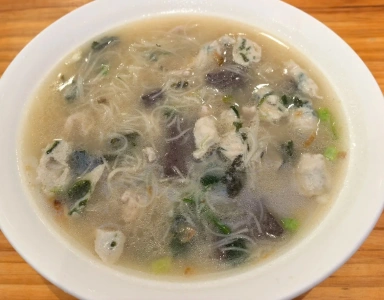
Mianxian hu is a signature breakfast dish in Xiamen. Ultra-fine rice noodles are simmered into a thick, silky soup base. Ingredients like oysters, pork liver, and dried shrimp are often added, along with scallions and white pepper. It’s a warm, savory bowl of comforting home-style flavor.
- Chinese Name: 面线糊
- Pinyin: miàn xiàn hú
- Main Ingredients: rice vermicelli, oysters, pork liver, dried shrimp, scallions and ginger
Shacha Noodles

Shacha noodles are a Xiamen specialty. The broth is flavored with shacha sauce, a rich paste made from soy, garlic, peanuts, and spices. Toppings vary by preference—beef slices, clams, tofu puffs, or seafood—making each bowl a personalized Xiamen-style breakfast.
- Chinese Name: 沙茶面
- Pinyin: shā chá miàn
- Main Ingredients: noodles, shacha sauce, beef slices, clams, tofu puffs
Peanut Soup
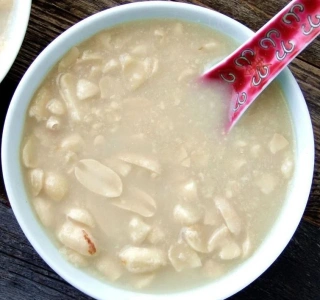
This sweet breakfast soup is beloved in Xiamen. Red-skin peanuts are slow-cooked until soft, then sweetened with sugar. Served warm and silky, it’s especially popular with kids and elders. Often paired with deep-fried pastries or steamed buns.
- Chinese Name: 花生汤
- Pinyin: huā shēng tāng
- Main Ingredients: peanuts, sugar, water
Fuzhou
As the capital of Fujian province, Fuzhou’s breakfast is light, soft, and deeply aromatic. Locals cherish a philosophy of “three soups a day,” starting each morning with a bowl of hot broth or soup noodles.
Want to explore Fuzhou’s specialty snacks and breakfast culture? Click here to view our [Fuzhou Food Guide].
Fuzhou Fish Balls

These fish balls are a regional favorite across Fujian. Made from finely ground fish paste stuffed with savory pork, the outer texture is springy while the inside is juicy. Served in a light broth with seaweed and scallions, they’re a beloved breakfast classic.
- Chinese Name: 福州鱼丸
- Pinyin: fú zhōu yú wán
- Main Ingredients: fish paste, pork, scallions, ginger, water
Guobian Hu (Rice Crust Soup)

This unique dish is somewhere between porridge and soup. Rice batter is poured around the edge of a hot wok, forming a sticky-soft base, then topped with oysters, dried shrimp, mushrooms, and fried shallots. The slightly thickened broth is deeply satisfying and not greasy.
- Chinese Name: 锅边糊
- Pinyin: guō biān hú
- Main Ingredients: rice batter, oysters, dried shrimp, mushrooms, shallots
Shacha Noodles

Fuzhou’s version of shacha noodles is similar to Xiamen’s, but the broth is lighter and more refined. The savory shacha aroma blends with the sweetness of seafood like clams or tofu puffs, creating a bowl full of “Fuzhou flavor.”
- Chinese Name: 沙茶面
- Pinyin: shā chá miàn
- Main Ingredients: shacha sauce, noodles, clams, tofu puffs, cilantro
Xi’an
As one of China’s ancient capitals, Xi’an offers hearty, no-nonsense breakfast fare rich in Northwestern character. Meat, noodles, and broth are the stars—one hula tang or a roujiamo can power you through a cold morning.
Curious about the bold and filling flavors of Xi’an’s breakfast? Click here to view our Xi’an Food Guide.
Roujiamo (Chinese Meat Burger)
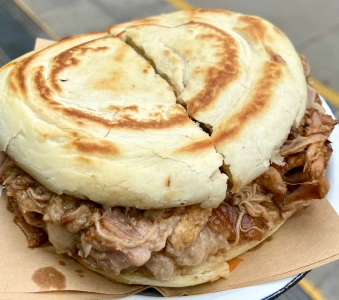
Known as the “Chinese hamburger,” roujiamo originated in Shaanxi and is a beloved breakfast staple. A crispy, fluffy baiji mo bun is filled with tender pork that’s been braised in five-spice sauce. Fragrant and filling, it’s a true taste of Xi’an.
- Chinese Name: 肉夹馍
- Pinyin: ròu jiā mó
- Main Ingredients: baiji mo bread, braised pork, five-spice seasoning, cilantro
Hula Tang (Spicy Pepper Soup)

This thick, spicy soup is a popular morning meal in northwestern China. It combines wood ear mushrooms, vermicelli, tofu skin, and thin beef slices in a broth thickened with starch and flavored with pepper and chili oil. Perfect for a cold day.
- Chinese Name: 胡辣汤
- Pinyin: hú là tāng
- Main Ingredients: wood ear fungus, vermicelli, tofu skin, beef, pepper, chili oil
Youcha Mahua (Savory Tea Soup with Crispy Twists)

Youcha is a roasted flour tea often served hot for breakfast. It’s commonly paired with crunchy mahua twists, creating a classic Xi’an combo. The tea is nutty and smooth, while the fried pastry adds a perfect contrast in texture.
- Chinese Name: 油茶麻花
- Pinyin: yóu chá má huā
- Main Ingredients: wheat flour, sesame, salt, sugar, fried dough twists
Harbin
As one of the key cities in Northeast China, Harbin’s breakfast is hearty, bold, and deeply influenced by Russian cuisine. Most morning meals here center around wheat-based dishes, served hot and filling—perfect for chilly mornings in this snowy city.
Want to explore Harbin’s classic northeastern breakfast? Click here to view our Harbin Food Guide.
Shaobing (Baked Flatbread)
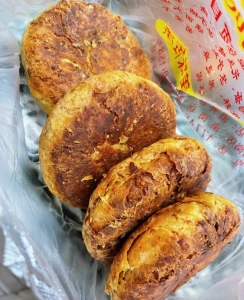
Unlike southern fried versions, Harbin’s shaobing is baked until golden and crisp outside, while staying soft inside. Sesame-topped is the most common, though meat- or sauce-filled versions are also popular. In winter, locals often pair it with soy milk or millet porridge for a warming street breakfast.
- Chinese Name: 烧饼
- Pinyin: shāo bǐng
- Main Ingredients: wheat flour, sesame seeds, yeast, oil, salt
Doufu Nao (Savory Tofu Pudding)

Northeastern-style doufu nao is always savory, and Harbin’s version is especially bold. Soybean curds are served with soy sauce, sesame oil, dried shrimp, shredded fungus, and minced pork. Compared to the sweet tofu desserts in the south, this one is rich and full of flavor.
- Chinese Name: 豆腐脑
- Pinyin: dòu fu nǎo
- Main Ingredients: soybeans, ground pork, wood ear mushroom, dried shrimp, soy sauce
Youzhagao (Fried Sticky Rice Cake)

A beloved sweet treat from the northeast, youzhagao is a deep-fried pastry with a crispy outside and soft, sweet filling—usually red bean paste or jujube paste. In Harbin winters, you’ll find these golden goodies at breakfast stalls, often paired with warm soy milk or millet porridge.
- Chinese Name: 油炸糕
- Pinyin: yóu zhá gāo
- Main Ingredients: glutinous rice flour, red bean paste or jujube paste, sugar, cooking oil
How to Try Traditional Chinese Breakfast as a Traveler
- 🥢 Walk into a morning market or street-side stall
- These are where locals go for the real deal.
- Best places: teahouses in Guangzhou, alley stalls in Chengdu, or neighborhood stands in Hangzhou.
- Tip: Follow the line of locals—you won’t go wrong.
- ⏰ Timing matters: wake up early
- Most breakfast vendors operate from 6:30 AM to 9:30 or 10:00 AM.
- Popular dishes like jianbing guozi or sticky rice wraps often sell out by 8:00 AM.
- Want the authentic experience? Skip the sleep-in.
- 📍 Some breakfasts are “regional only”
- Douzhi in Beijing, guobian hu in Fuzhou, red rice rolls in Guangzhou, or youcha in Chongqing—these are local treasures you won’t find elsewhere.
- Eating them where they originated is a cultural experience, not just a meal.
- Tip: If you see “jianbing” everywhere, try the real deal in Beijing for its original flavor.
- 💡 Best rule? Follow the crowds
- Don’t rely on apps—crowds are the best quality indicator.
- Don’t speak Chinese? No problem—point, nod, and smile, it works.
- Don’t fear a little smoke or noise—the best breakfasts are the most down-to-earth.
- 🎒 Bring tissues and small change
- Some stalls only take cash or Chinese mobile payments—bring small bills just in case.
- Napkins usually aren’t provided—carry your own tissues as a golden rule.
FAQ
Chinese breakfast is typically eaten between 6:30 AM and 9:00 AM. Most street vendors and small eateries close their breakfast service by around 10:00 AM.
Most traditional Chinese breakfasts are savory, such as noodles, buns, and congee. However, some items like soy milk or sesame balls can be mildly sweet, depending on the region.
Yes, many breakfast foods like steamed buns with vegetables, soy milk, fried dough sticks, and congee with pickles are vegetarian-friendly. That said, always ask, as some dishes may include hidden animal-based seasonings.
It can be! Dishes like congee, steamed buns, and soy milk offer nutritional value with low oil content, though deep-fried options like youtiao are best in moderation. Overall, it’s balanced and portion-controlled.
The best way is to follow locals to neighborhood breakfast stalls, morning wet markets, or small “xiaochi” (小吃) shops—especially between 7 and 9 AM in residential areas of cities.

 English (US)
English (US)  English (Hong Kong)
English (Hong Kong)  English (Malaysia)
English (Malaysia)  English (Singapore)
English (Singapore)  繁體中文
繁體中文 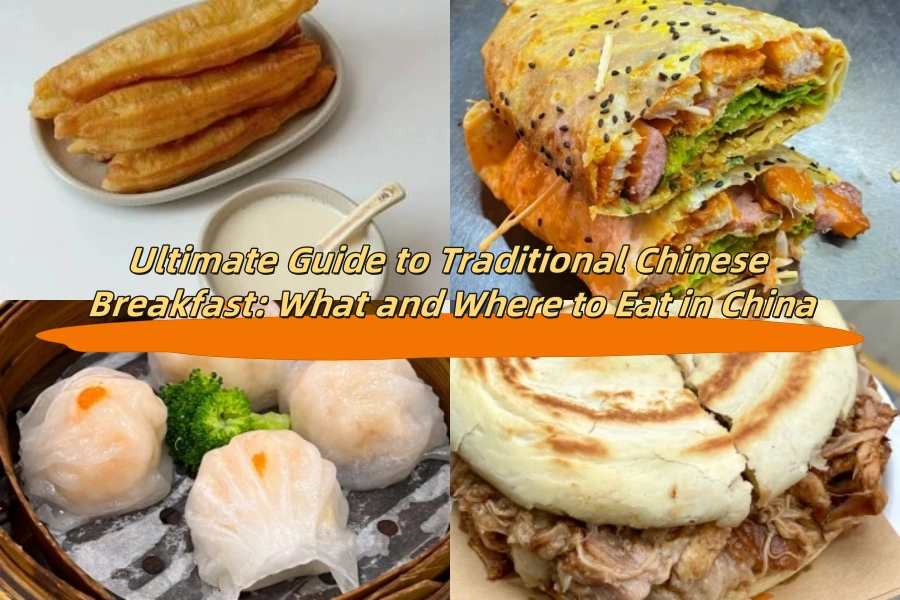
Comment (0)